Using Fuzzy Cognitive Maps to Assess Liveability in Slum Upgrading Schemes: Case of Pune, India
Abstract
:1. Introduction
1.1. Background
1.2. Liveability Indicators
2. Materials and Methods
- Neighbourhood 1—Shinde Vasti: Slum with no intervention.
- Neighbourhood 2—Laxmi Nagar: Slum upgraded by retrofitting.
- Neighbourhood 3—Kamela: Slum temporarily relocated to transit housing. This is considered a substitute for upgrading by relocation since no interviewees could be contacted in a relocated neighbourhood and the transit housing share similar characteristic of a relocated housing.
- Neighbourhood 4—Dattawadi: In-situ redevelopment by shifting to multi-storey housing.
2.1. Semi-Structured Interviews
- The first question elicits the interviewees’ general perception about their neighbourhood, whether they are satisfied, or whether they think it can be improved, or are dissatisfied. To minimize language barriers during the interviews, the wording chosen for this three-point scale answers were “a lot” (satisfied), “a bit” (can be improved), and “not at all” (dissatisfied).
- The second set of questions finds how they rated the performance of the 13 selected liveability indicators, with the same three-point scale. Indicators which are inherently improved during the upgrading process, like the Quality of Housing, Access to Basic Amenities, and Security of Tenure were left from the next round of questions and mapping since their performance has objectively improved through the upgrading. Of the remaining indicators, the ones which were not rated satisfactory were taken forward to check how their performance can be positively influenced by other indicators. This limits the number of causal relationships which is crucial to limit the time taken for each interview. When time is not a constraint, finding a causal relationship between all indicators would be preferred for optimal results.
- The third set of questions attempts to identify the interlinkages between the indicators, the potential of indicators to improve those that were rated either “not at all” (unsatisfactory) or “a bit” (can be improved), based on the interviewees’ perception. Depending on whether the indicators were thought to have some influence in improving the unsatisfactory indicators, they could be rated from “no influence” (influence value 0) to “very little” (influence value = 0.3), “a bit” (influence value = 0.6), and “a lot” (influence value = 1.0).
2.2. Fuzzy Cognitive Maps (FCMs)
2.2.1. Components of an FCM
- Concepts (from here on as Liveability Indicators (LI)): They represent the drivers/indicators that have influence (causation) on the system in consideration and can be represented with LI1, LI2 … LIn. They can be defined contextually and need not have a dimensional definition.
- Directed edges: Arrows with signs (+/−) depicting the relationships between concepts (causality), indicating that a concept causes another concept. A positive correlation ‘+’ between LI1 and LI2 means increasing LI1 increases LI2 and decreasing LI1 decreases LI2 while the reverse is the case for a negative correlation ‘−’.
- Weight of directed edge: While the directed edges or arrows with signs show a causal relation between two indicators, the weight (between 0 and 1) shows the degree to which one indicator causes another. The stronger the causation, negative or positive, the closer the value is to 1 and the weaker the causation, the closer the value is to 0.
- Adjacency Matrix: Mathematical representation of the FCM to analyse the centrality of a concept or indicator (conceptual centrality) and the role of each component in the network, whether it is ordinary, driver/transmitter or receiver.
2.2.2. Drawing and Aggregating FCMs
- Indicators not rated satisfactory (“not at all” or “a bit”) by the interviewees are taken forward to check how their performance can be improved by other indicators.
- To determine the interlinkages, the responses gathered from the questionnaire were transformed into respective FCMs using the software “Mental Modeler” and “FCM Expert”.
- Degree Centrality is calculated for all indicators from each interviewee using the Adjacency Matrix.
- The FCMs of interviewees from each neighbourhood are aggregated into one, resulting in four neighbourhood level FCMs, which highlight all the indicators considered relevant by the interviewees of each neighbourhood. For aggregation, the total weight of each directed edge is calculated via matrix addition to derive a new aggregated adjacency matrix. All individual FCMs are weighted equally in the aggregation. The aggregated FCMs can be normalized by dividing the matrix elements by the number of individual interviews [20,50]. This has been done in Figure 15 for better comparability across the four slums.
3. Results
3.1. Neighbourhood 1: Shinde Vasti, Hadapsar: Informal Settlement with No Intervention
3.2. Neighbourhood 2: Laxmi Nagar, Yerwada. Upgrading by Retrofitting
3.3. Neighbourhood 3: Kamela, Kondhwa. Transit Housing for SRA In-Situ Multi-Storey Housing
3.4. Neighbourhood 4: Dattawadi SRA In-Situ Multi-Storey Housing
4. Discussion
- Contextualizing indicators: As pointed out in the introduction, liveability indicators for informal urban contexts are still scarce. Building on the indicators presented in this work, on-the-ground contextualization could greatly benefit the local applicability of liability indicators. This could be achieved through conducting workshops with field experts like NGOs, CBOs and local municipality, stakeholders, and academics.
- Tripartite partnership: As our results show, community agency plays a vital role in successful rehabilitation. Enabling partnership between CBOs, NGOs and the municipality is important to vocalize resident concerns and ensure that built-environment upgradations consider the social habits of the neighbourhood.
- Integration to the formal city fabric: Strategies need to be developed for comprehensive integration of the rehabilitated neighbourhoods to the formal city fabric, safeguarding access to the various functional attributes of liveability, like proximity and access to public transport, education, healthcare.
- Mandating periodic liveability assessments: Credible before- and after rehabilitation evaluations are required to better capture the actual effect of the intervention. In particular, Post-Occupancy Liveability Evaluation (POLE) could ensure the workability of completed projects as well as gathering feedback on residents’ change in liveability.
5. Conclusions
Supplementary Materials
Author Contributions
Funding
Institutional Review Board Statement
Informed Consent Statement
Data Availability Statement
Acknowledgments
Conflicts of Interest
References
- UN-Habitat. The Challenge of Slums: Global Report on Human Settlements, 2003; Earthscan Publications: London, UK; Sterling, VA, USA, 2003. [Google Scholar]
- Jain, V.; Chennuri, S.; Karamchandani, A. Informal Housing, Inadequate Property Rights: Understanding the Needs of India’s Informal Housing Dwellers; FSG: Mumbai, India, 2016. [Google Scholar]
- UNSD. SDG Report 2019: 11 Sustainable Cities and Communities. Available online: https://unstats.un.org/sdgs/report/2019/goal-11/ (accessed on 29 February 2020).
- Ministry of Home Affairs, Government of India, Census: Population Enumeration Data (Final Population). Available online: https://www.censusindia.gov.in/2011census/population_enumeration.html (accessed on 22 December 2020).
- UN-Habitat. A Practical Guide to Designing, Planning, and Executing Citywide Slum Upgrading Programmes; United Nations Human Settlements Programme (UN-Habitat): Nairobi, Kenya, 2014; p. 167. [Google Scholar]
- EIU. The Global Liveability Index 2019. Available online: https://www.eiu.com/public/topical_report.aspx?campaignid=liveability2019 (accessed on 15 March 2020).
- Kashef, M. Urban Livability across Disciplinary and Professional Boundaries. Front. Archit. Res. 2016, 5, 239–253. [Google Scholar] [CrossRef] [Green Version]
- Mercer. Vienna tops Mercer’s 21st Quality of Living Ranking. Available online: https://www.mercer.com/newsroom/2019-quality-of-living-survey.html (accessed on 15 November 2020).
- OECD. How’s Life? 2020: Measuring Well-Being; OECD: Paris, France, 2020. [Google Scholar]
- Census of India. Primary Census Abstract for Slum; Census of India: New Delhi, India, 2013. [Google Scholar]
- Nolan, L.B. Slum Definitions in Urban India: Implications for the Measurement of Health Inequalities. Popul. Dev. Rev. 2015, 41, 59–84. [Google Scholar] [CrossRef] [Green Version]
- Alam, S.S.B.; Mihoko, M. Dwellers’ Satisfaction on Slum Rehabilitation Scheme and its Affecting Factors in Mumbai, India. Urban Reg. Plan. Rev. 2018, 5, 67–86. [Google Scholar]
- Cronin, V. A Sustainability Evaluation of Slum Rehabilitation Authority Housing Development at Nanapeth, Pune, India. Environ. Urban. ASIA 2013, 4, 121–134. [Google Scholar] [CrossRef]
- Kshetrimayum, B.; Bardhan, R.; Kubota, T. Factors Affecting Residential Satisfaction in Slum Rehabilitation Housing in Mumbai. Sustainability 2020, 12, 2344. [Google Scholar] [CrossRef] [Green Version]
- Debnath, R.; Bardhan, R.; Sunikka-Blank, M. Discomfort and Distress in Sum Rehabilitation: Investigating a Rebound Phenomenon Using a Backcasting Approach. Habitat Int. 2019, 87, 75–90. [Google Scholar] [CrossRef]
- UN-Habitat. Metadata on SDGs Indicator 11.2.1 Indicator Category: Tier II. Available online: https://unhabitat.org/sites/default/files/2020/06/metadata_on_sdg_indicator_11.2.1.pdf (accessed on 1 April 2021).
- Ministry of Urban Development. Liveability Standards in Cities; Government of India, Ministry of Urban Development: New Delhi, India, 2017.
- Higgs, C.; Badland, H.; Simons, K.; Knibbs, L.D.; Giles-Corti, B. The Urban Liveability Index: Developing a policy-relevant urban liveability composite measure and evaluating associations with transport mode choice. Int. J. Health Geogr. 2019, 18, 1–25. [Google Scholar] [CrossRef] [Green Version]
- Council, N.R. Community and Quality of Life; National Academies Press: Washington, DC, USA, 2002; p. 208. [Google Scholar]
- Özesmi, U.; Özesmi, S.L. Ecological models based on people’s knowledge: A multi-step fuzzy cognitive mapping approach. Ecol. Model. 2004, 176, 43–64. [Google Scholar] [CrossRef] [Green Version]
- Census of India. Top 10 Urban Agglomeration of India by Population 2011. Available online: https://www.census2011.co.in/facts/topurbanpopulation.html (accessed on 5 January 2021).
- Census of India. Pune Metropolitan Urban Region Population 2011–2021 Census. Available online: https://www.census2011.co.in/census/metropolitan/306-pune.html (accessed on 5 January 2021).
- PMC. City Census Department|Home|Pune Municipal Corporation. Available online: https://www.pmc.gov.in/en/census (accessed on 5 January 2021).
- PMC. PMC Open Data Store: Census Population of Slums. 2009. Available online: http://opendata.punecorporation.org/Citizen/CitizenDatasets/Index (accessed on 5 January 2021).
- PMC. Revising/Updating City Development Plan (CDP) of Pune City-2041: Under JNNURM; PMC: Pune, India, 2012. [Google Scholar]
- Maps of India. Where is Pune Located. Available online: https://www.mapsofindia.com/india/where-is-pune.html (accessed on 20 March 2020).
- PMC. Pune City Map. Available online: https://www.pmc.gov.in/en/image-gallery/album-images/14221 (accessed on 17 April 2020).
- Alderton, A.; Davern, M.; Nitvimol, K.; Butterworth, I.; Higgs, C.; Ryan, E.; Badland, H. What is the Meaning of Urban Liveability for a City in a Low-to-Middle-Income Country? Contextualising liveability for Bangkok, Thailand. Glob. Health 2019, 15, 51. [Google Scholar] [CrossRef] [Green Version]
- UN. Final List of Proposed Sustainable Development Goal Indicators: Report of the Inter-Agency and Expert Group on Sustainable Development Goal Indicator; UN: New York, NY, USA, 2016. [Google Scholar]
- UNGA. New Urban Agenda; UN: Quito, Ecuador, 2017. [Google Scholar]
- Leby, L.J.; Hashim, H.A. Liveability Dimensions and Attributes: Their Relative Importance in the Eyes of Neighbourhoods Residents. J. Constr. Dev. Ctries. 2010, 15, 67–91. [Google Scholar]
- Kovacs-Györi, A.; Cabrera-Barona, P.; Resch, B.; Mehaffy, M.; Blaschke, T. Assessing and Representing Livability through the Analysis of Residential Preference. Sustainability 2019, 11, 4934. [Google Scholar] [CrossRef] [Green Version]
- Onnom, W.; Tripathi, N.; Nitivattananon, V.; Ninsawat, S. Development of a Liveable City Index (LCI) Using Multi Criteria Geospatial Modelling for Medium Class Cities in Developing Countries. Sustainability 2018, 10, 520. [Google Scholar] [CrossRef] [Green Version]
- UN-Habitat. The State of the World Cities Report 2006/2007; UN-Habitat: Nairobi, Kenya, 2006. [Google Scholar]
- Patel, S. Upgrade, rehouse or resettle? An assessment of the Indian government’s Basic Services for the Urban Poor (BSUP) programme. Environ. Urban. 2013, 25, 177–188. [Google Scholar] [CrossRef]
- Nijman, J. Against the Odds: Slum Rehabilitation in Neoliberal Mumbai. Cities 2008, 25, 73–85. [Google Scholar]
- Nijman, J. India’s Urban Future. Am. Behav. Sci. 2015, 59, 406–423. [Google Scholar] [CrossRef]
- Farahani, L.M. The Value of the Sense of Community and Neighbouring. Hous. Theory Soc. 2016, 33, 357–376. [Google Scholar] [CrossRef]
- Jacobs, J. The Death and Life of Great American Cities; Vintage Books ed.; Vintage Books: New York, NY, USA, 1992; p. 458. [Google Scholar]
- ActiveHealthyCommunities. PedShed Analysis—Active Healthy Communities. Available online: http://www.activehealthycommunities.com.au/plan/gis-analysis/walking-cycling-pedshed-analysis/ (accessed on 4 August 2020).
- MASHAL. Pune Slum Atlas; CHF International: Pune, India, 2011. [Google Scholar]
- ShelterAssociates. Slum Data. Available online: https://shelter-associates.org/ (accessed on 7 March 2021).
- Yoon, B.S.; Jetter, A.J. Comparative Analysis for Fuzzy Cognitive Mapping. In Proceedings of the PICMET’16: Technology Management for Social Innovation, Honolulu, HI, USA, 4–8 September 2016; pp. 1897–1908. [Google Scholar]
- Isak, K.G.Q.; Wildenberg, M.; Adamescu, C.M.; Skov, F.; De Blust, G.; Varjopuro, R. Manual for Applying Fuzzy Cognitive Mapping—Experiences from ALTER-Net, WPR6-2009-02; ALTER-Net: Brussels, Belgium, 2009. [Google Scholar]
- Bottero, M.; Datola, G.; Monaco, R. Exploring the Resilience of Urban Systems Using Fuzzy Cognitive Maps. In Computational Science and its Applications —ICCSA 2017, Proceedings of the 17th International Conference, Trieste, Italy, 3–6 July 2017; Gervasi, O., Murgante, B., Misra, S., Borruso, G., Torre, C.M., Rocha, A.M.A.C., Taniar, D., Apduhan, B.O., Stankova, E., Cuzzocrea, A., Eds.; Springer: Cham, Switzerland, 2017; Volume 3, pp. 338–353. [Google Scholar]
- Perusich, K. (Ed.) Cognitive Maps; IntechOpen: Rijeka, Croatia, 2010. [Google Scholar]
- Helfgott, A.; Lord, S.; Bean, N.; Wildenberg, M.; Gray, S.; Gray, S.; Vervoort, J.; Kok, K.; Ingram, J. Clarifying Fuzziness: Fuzzy Cognitive Maps, Neural Networks and System Dynamics Models in Participatory Social and Environmental Decision-Aiding Processes; TRANSMANGO: Leuven, Belgium, 2015. [Google Scholar]
- Kosko, B. Fuzzy Cognitive Maps. Int. J. Man Mach. Stud. 1986, 24, 65–75. [Google Scholar] [CrossRef]
- Nápoles, G.; Grau, I.; León, M.; Grau, R. Modelling, Aggregation and Simulation of a Dynamic Biological System through Fuzzy Cognitive Maps. In Advances in Artificial and Computational Intelligence; Batyrshin, I., González Mendoza, M., Eds.; Springer: Heidelberg, Germany, 2013; pp. 188–199. [Google Scholar]
- Kosko, B. Hidden Patterns in Combined and Adaptive Knowledge Networks. Int. J. Approx. Reason. 1998, 2, 377–393. [Google Scholar]
- GoogleEarth, Version 9.132.1.1; Google: Menlo Park, CA, USA, 2021.
- Biswas, P.S. Yerwada Slum Project Not for Profit: NGO. DNA. 30 March 2011. Available online: https://www.dnaindia.com/mumbai/report-yerawada-slum-project-in-pune-not-for-profit-ngo-1526299 (accessed on 7 March 2021).
- TNN. 272 Slum Structures Pulled Down; The Times of India: Pune, India. 2017; Available online: https://timesofindia.indiatimes.com/city/pune/272-slum-structures-pulled-down/articleshow/58287429.cms (accessed on 7 March 2021).
- Singh, K. Strengthening community-based organizations for Slum Development. Int. J. Res. Publ. Semin. 2016, 7. Available online: https://www.academia.edu/32835021/Strengthening_community_based_organizations_for_slum_Development (accessed on 7 March 2021).
- Zhang, Y. Building a Slum-Free Mumbai. Available online: https://www.wilsoncenter.org/article/building-slum-free-mumbai (accessed on 30 July 2020).
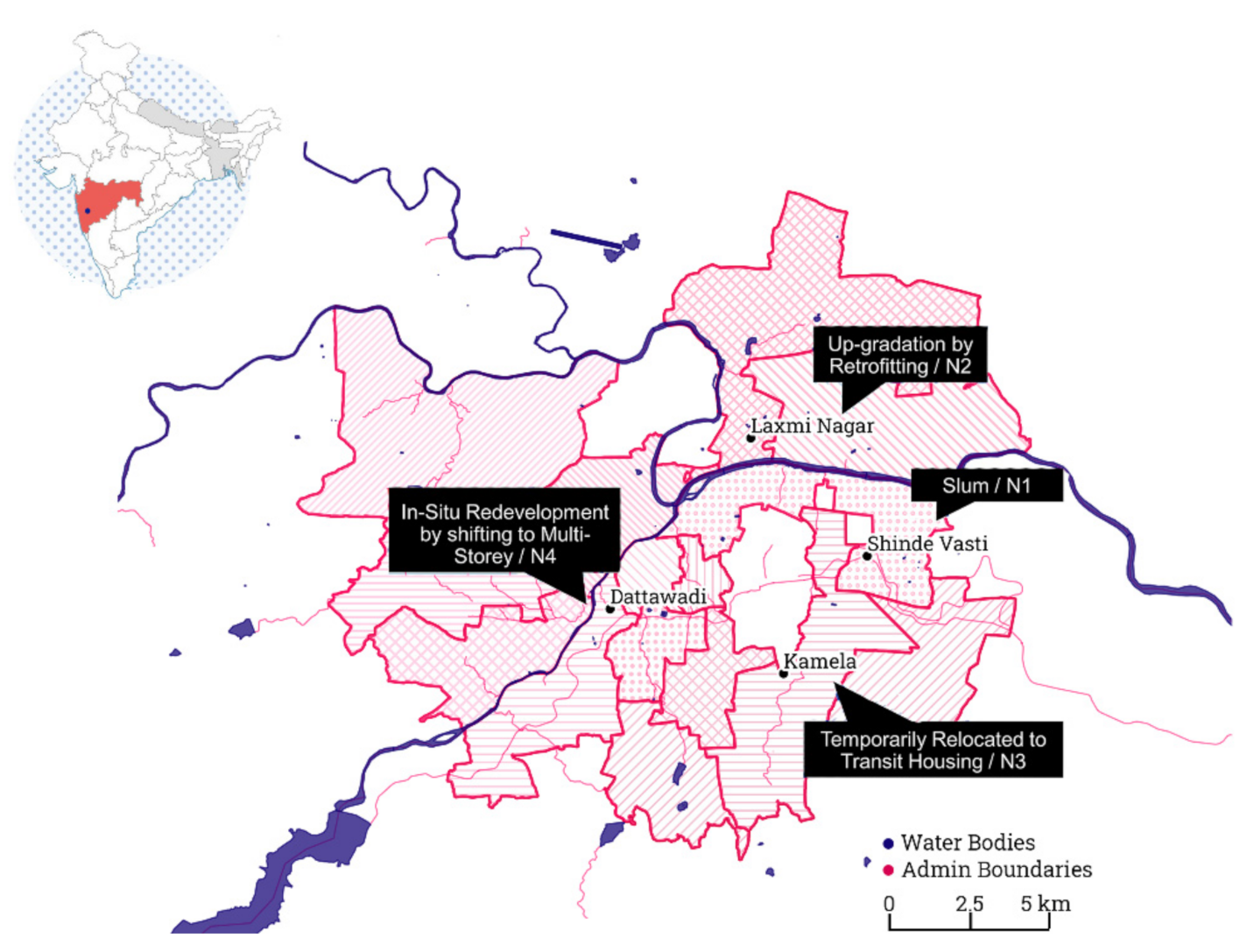

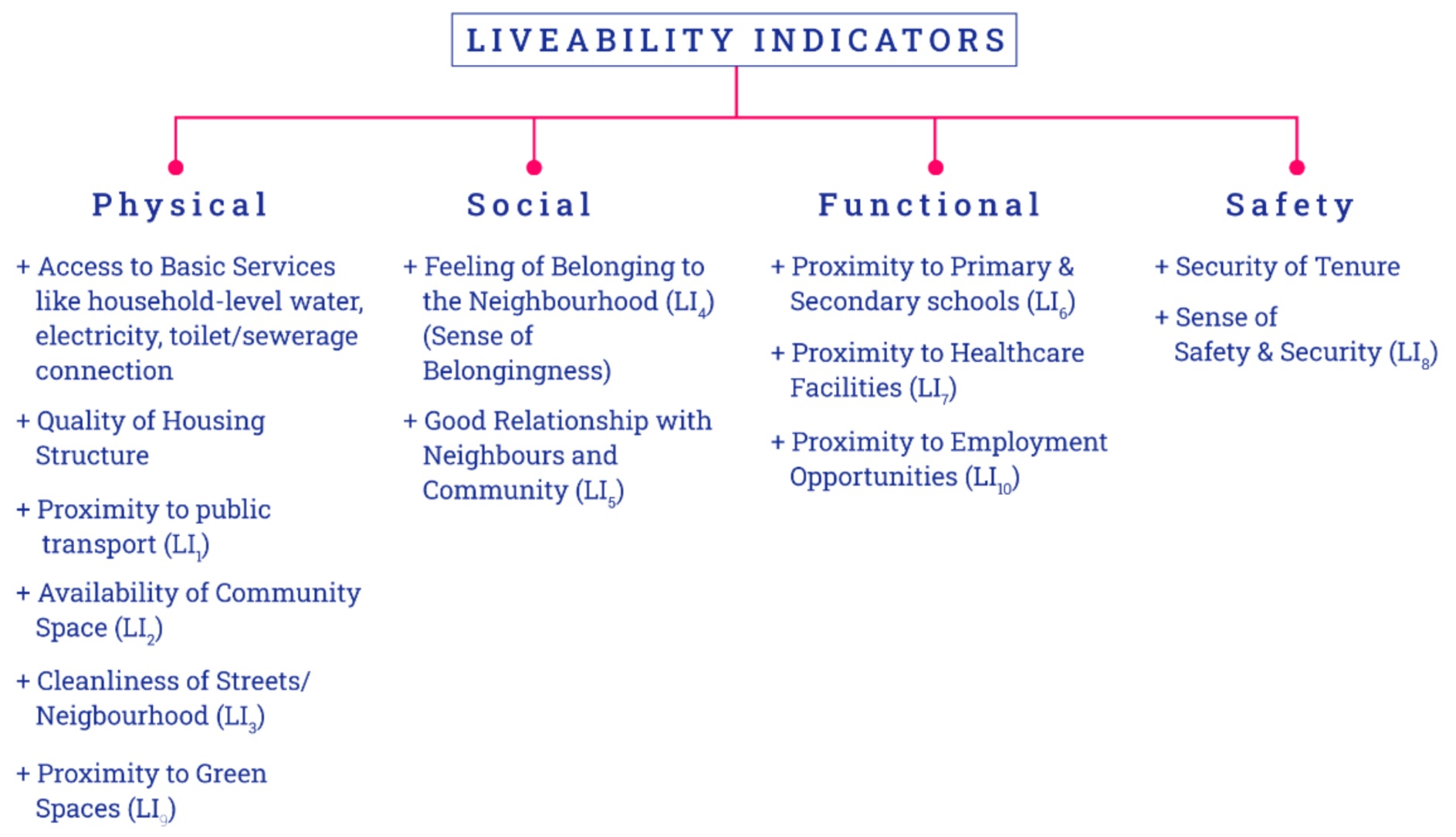

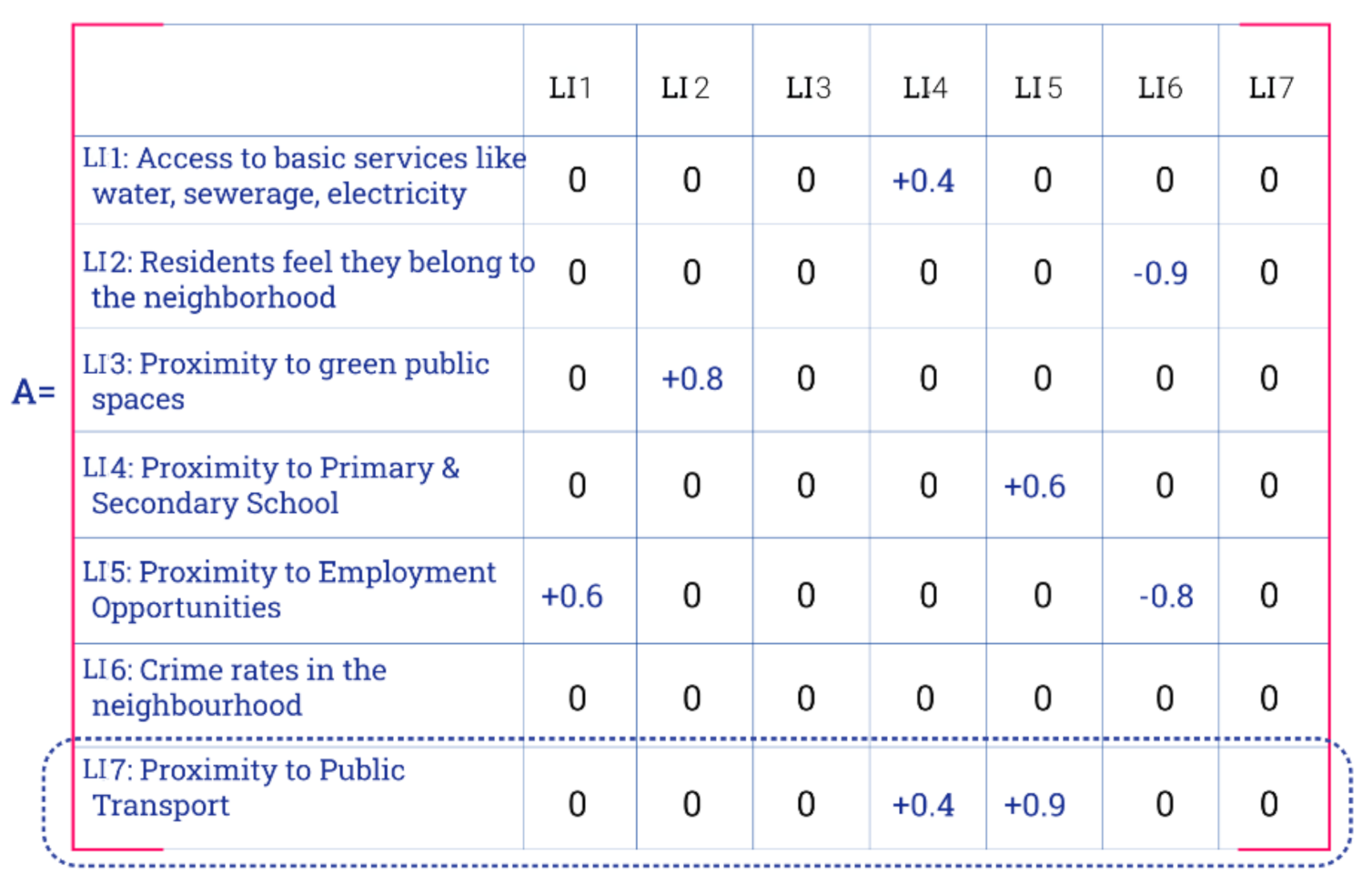

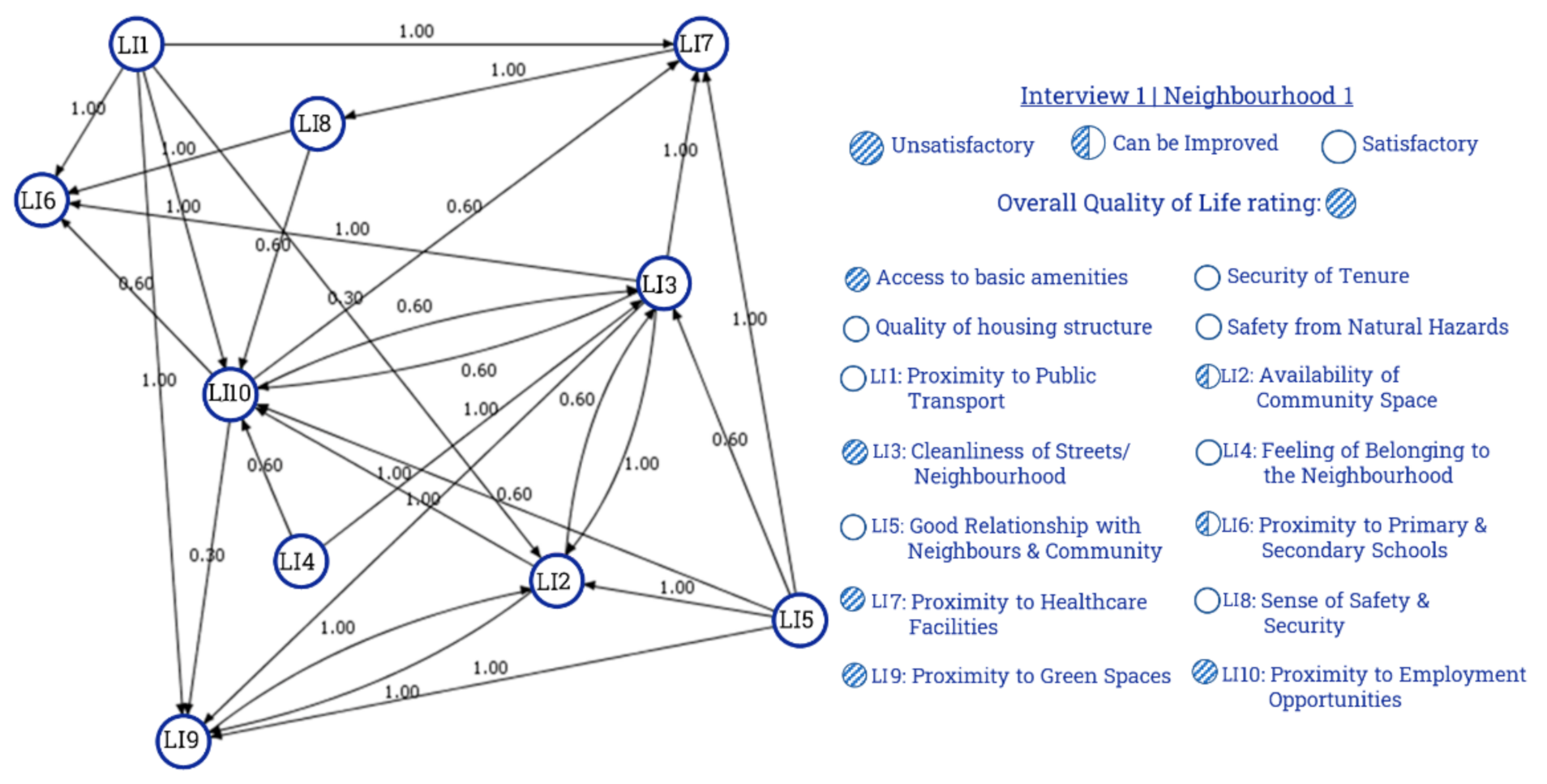
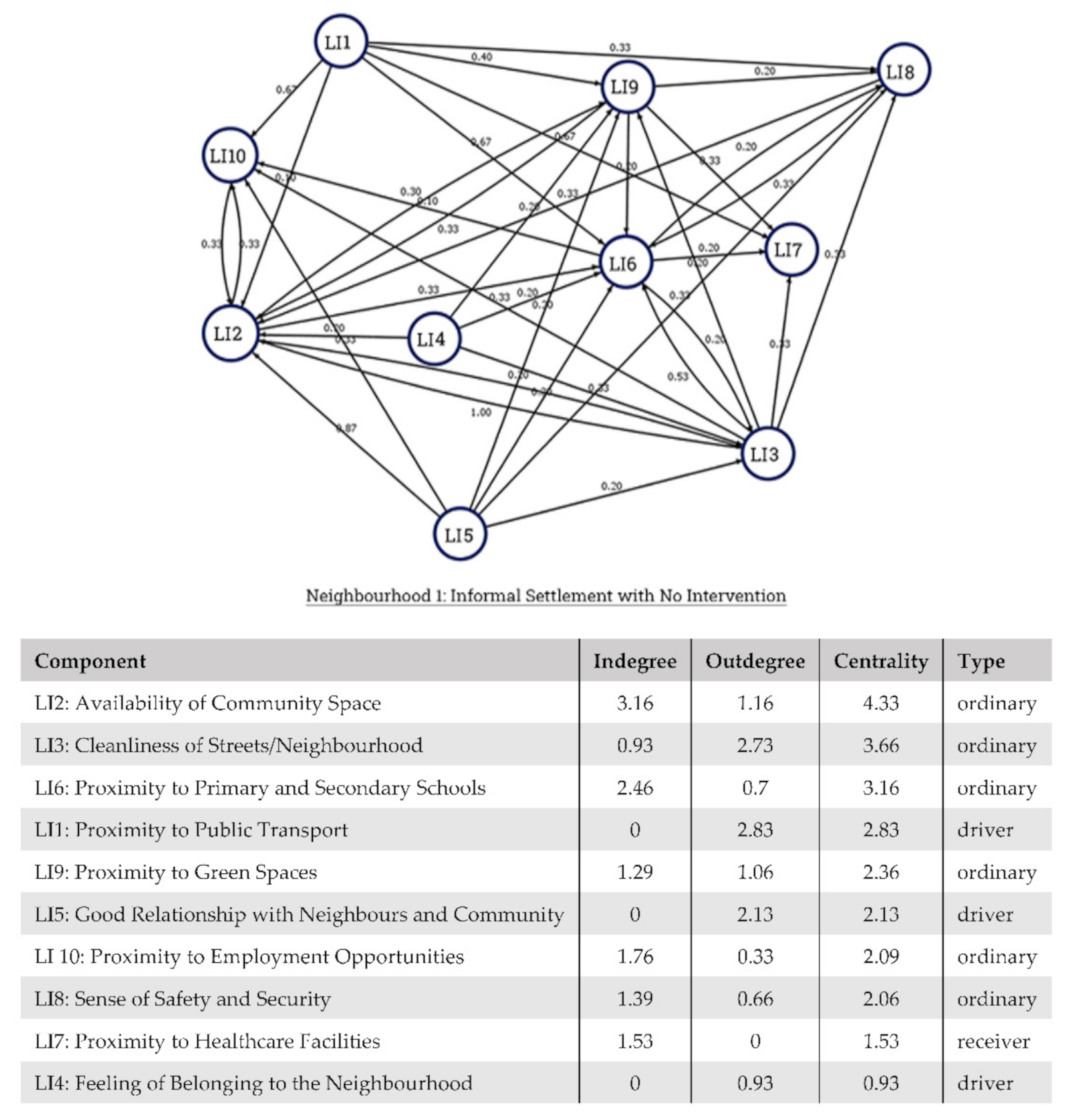
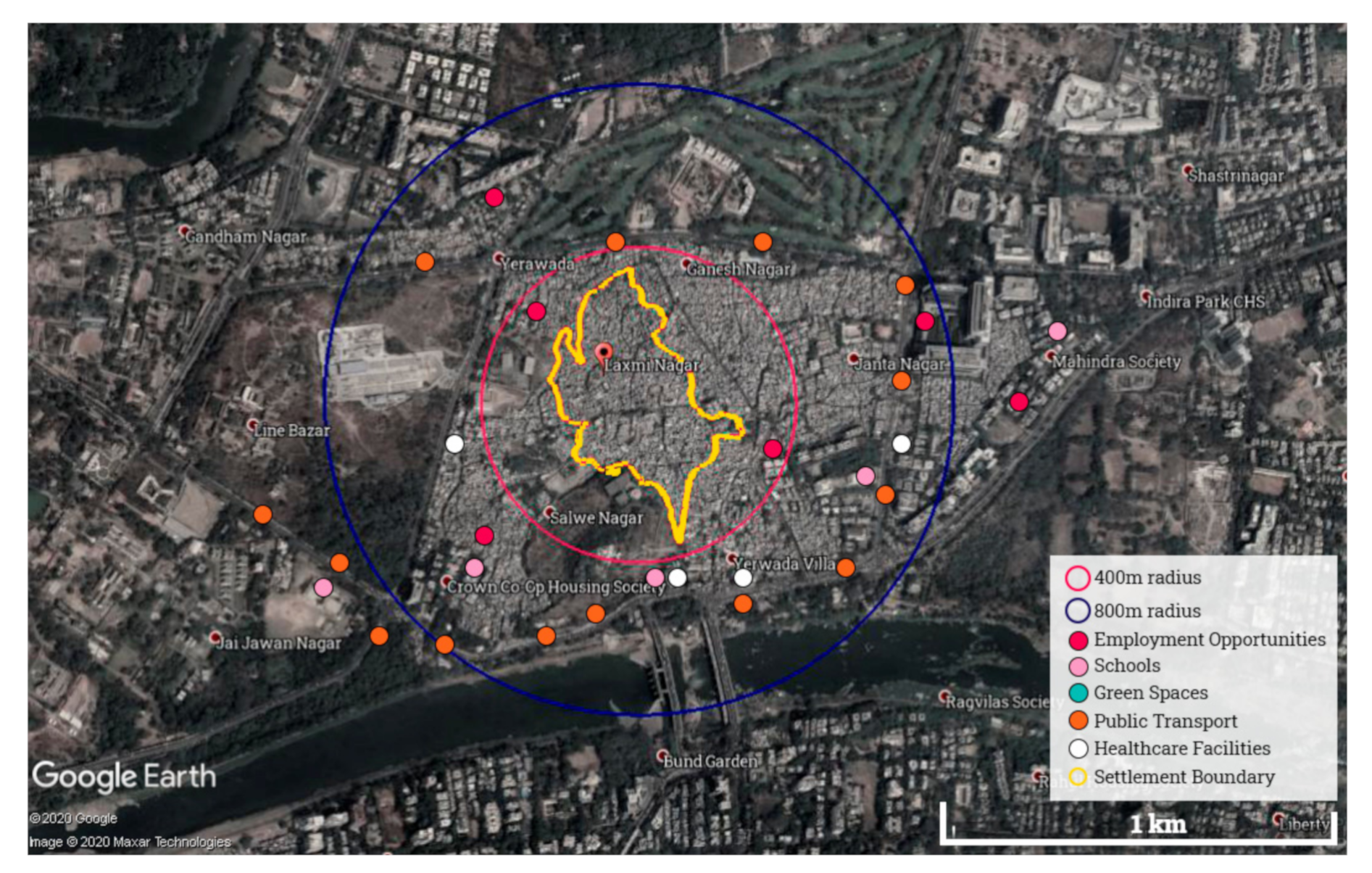
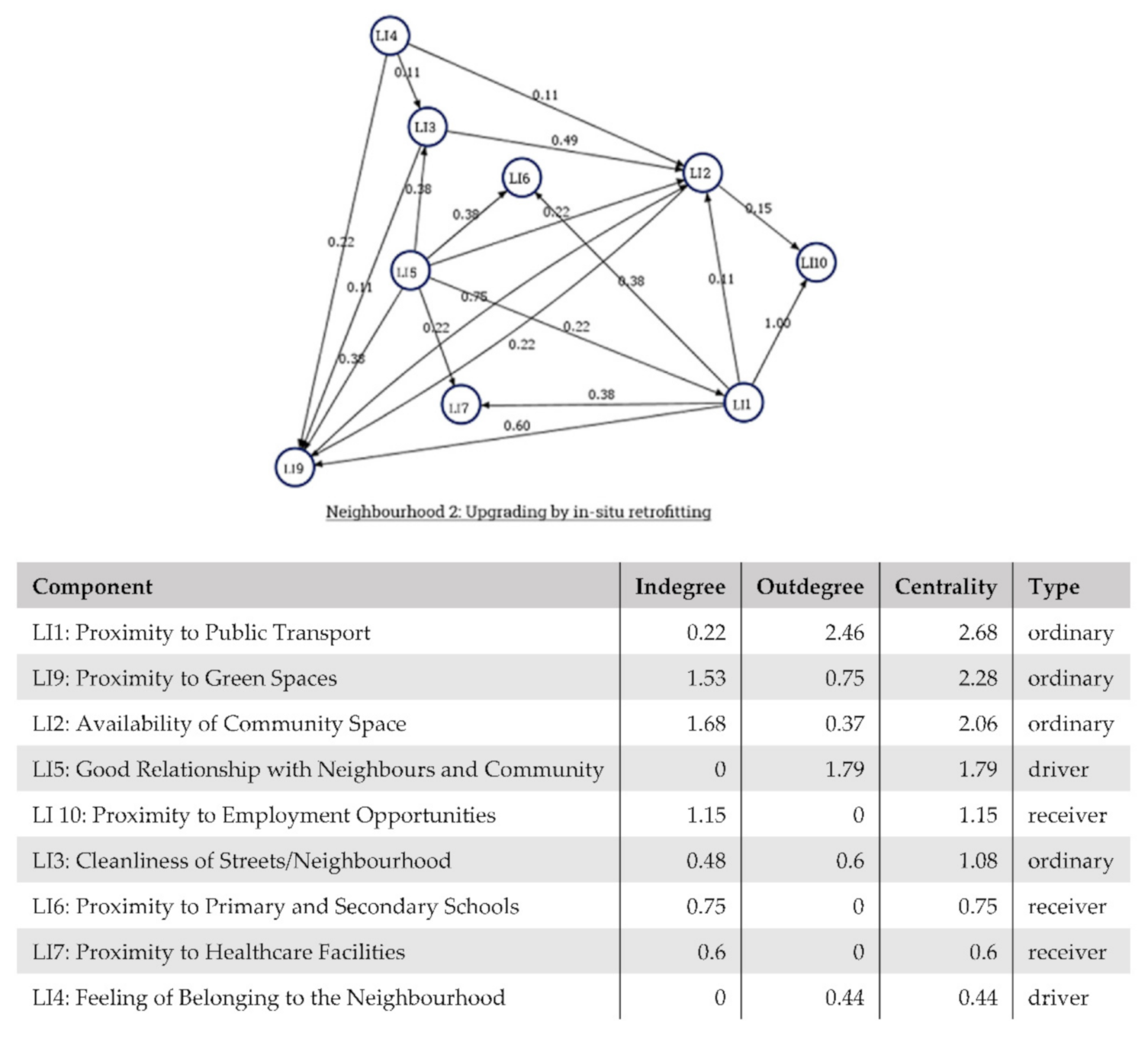



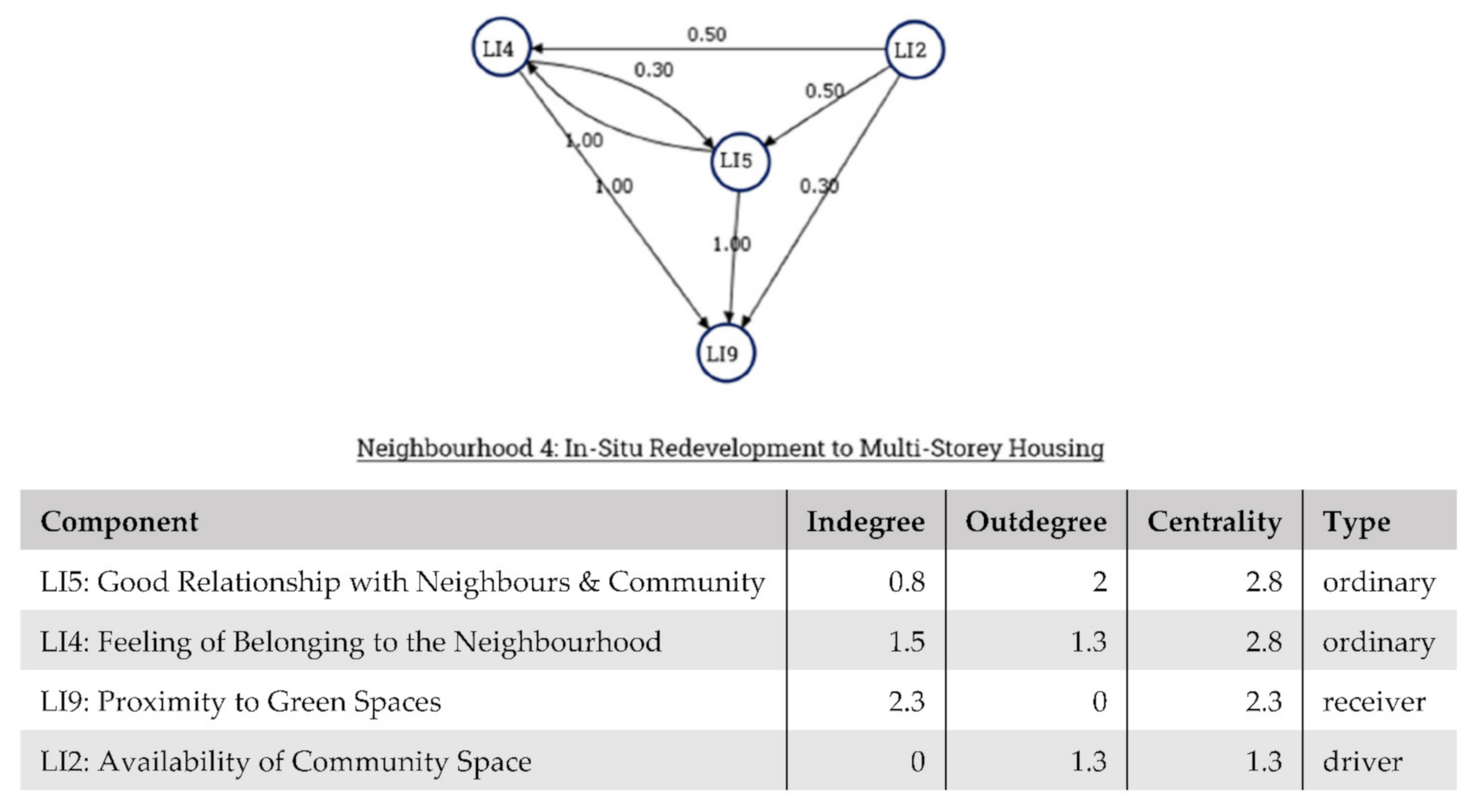

Publisher’s Note: MDPI stays neutral with regard to jurisdictional claims in published maps and institutional affiliations. |
© 2021 by the authors. Licensee MDPI, Basel, Switzerland. This article is an open access article distributed under the terms and conditions of the Creative Commons Attribution (CC BY) license (https://creativecommons.org/licenses/by/4.0/).
Share and Cite
Nath, S.; Karutz, R. Using Fuzzy Cognitive Maps to Assess Liveability in Slum Upgrading Schemes: Case of Pune, India. Urban Sci. 2021, 5, 44. https://0-doi-org.brum.beds.ac.uk/10.3390/urbansci5020044
Nath S, Karutz R. Using Fuzzy Cognitive Maps to Assess Liveability in Slum Upgrading Schemes: Case of Pune, India. Urban Science. 2021; 5(2):44. https://0-doi-org.brum.beds.ac.uk/10.3390/urbansci5020044
Chicago/Turabian StyleNath, Subhashree, and Raphael Karutz. 2021. "Using Fuzzy Cognitive Maps to Assess Liveability in Slum Upgrading Schemes: Case of Pune, India" Urban Science 5, no. 2: 44. https://0-doi-org.brum.beds.ac.uk/10.3390/urbansci5020044





